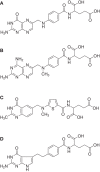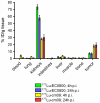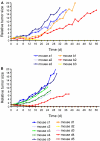Prospects in folate receptor-targeted radionuclide therapy
- PMID: 24069581
- PMCID: PMC3781362
- DOI: 10.3389/fonc.2013.00249
Prospects in folate receptor-targeted radionuclide therapy
Abstract
Targeted radionuclide therapy is based on systemic application of particle-emitting radiopharmaceuticals which are directed toward a specific tumor-associated target. Accumulation of the radiopharmaceutical in targeted cancer cells results in high doses of absorbed radiation energy whereas toxicity to non-targeted healthy tissue is limited. This strategy has found widespread application in the palliative treatment of neuroendocrine tumors using somatostatin-based radiopeptides. The folate receptor (FR) has been identified as a target associated with a variety of frequent tumor types (e.g., ovarian, lung, brain, renal, and colorectal cancer). In healthy organs and tissue FR-expression is restricted to only a few sites such as for instance the kidneys. This demonstrates why FR-targeting is an attractive strategy for the development of new therapy concepts. Due to its high FR-binding affinity (K D < 10(-9) M) the vitamin folic acid has emerged as an almost ideal targeting agent. Therefore, a variety of folic acid radioconjugates for nuclear imaging have been developed. However, in spite of the large number of cancer patients who could benefit of a folate-based radionuclide therapy, a therapeutic concept with folate radioconjugates has not yet been envisaged for clinical application. The reason is the generally high accumulation of folate radioconjugates in the kidneys where emission of particle-radiation may result in damage to the renal tissue. Therefore, the design of more sophisticated folate radioconjugates providing improved tissue distribution profiles are needed. This review article summarizes recent developments with regard to a therapeutic application of folate radioconjugates. A new construct of a folate radioconjugate and an application protocol which makes use of a pharmacological interaction allowed the first preclinical therapy experiments with radiofolates. These results raise hope for future application of such new concepts also in the clinic.
Keywords: cancer; folate receptor; folic acid; radionuclide therapy.
Figures








Similar articles
-
Folate receptor-targeted radionuclide therapy: preclinical investigation of anti-tumor effects and potential radionephropathy.Nucl Med Biol. 2015 Oct;42(10):770-9. doi: 10.1016/j.nucmedbio.2015.06.006. Epub 2015 Jun 11. Nucl Med Biol. 2015. PMID: 26162583
-
Preclinical development of small-molecular-weight folate-based radioconjugates: a pharmacological perspective.Q J Nucl Med Mol Imaging. 2015 Sep;59(3):269-86. Epub 2015 Jul 7. Q J Nucl Med Mol Imaging. 2015. PMID: 26149341 Review.
-
Pharmacokinetic Properties of 68Ga-labelled Folic Acid Conjugates: Improvement Using HEHE Tag.Molecules. 2020 Jun 11;25(11):2712. doi: 10.3390/molecules25112712. Molecules. 2020. PMID: 32545327 Free PMC article.
-
DOTA conjugate with an albumin-binding entity enables the first folic acid-targeted 177Lu-radionuclide tumor therapy in mice.J Nucl Med. 2013 Jan;54(1):124-31. doi: 10.2967/jnumed.112.107235. Epub 2012 Dec 12. J Nucl Med. 2013. PMID: 23236020
-
Folate based radiopharmaceuticals for imaging and therapy of cancer and inflammation.Curr Pharm Des. 2012;18(8):1058-83. doi: 10.2174/138161212799315777. Curr Pharm Des. 2012. PMID: 22272825 Review.
Cited by
-
Combining Albumin-Binding Properties and Interaction with Pemetrexed to Improve the Tissue Distribution of Radiofolates.Molecules. 2018 Jun 16;23(6):1465. doi: 10.3390/molecules23061465. Molecules. 2018. PMID: 29914162 Free PMC article.
-
Folate receptor targeting of radiolabeled liposomes reduces intratumoral liposome accumulation in human KB carcinoma xenografts.Int J Nanomedicine. 2018 Nov 19;13:7647-7656. doi: 10.2147/IJN.S182579. eCollection 2018. Int J Nanomedicine. 2018. PMID: 30538449 Free PMC article.
-
Nanomedicines for cancer therapy: state-of-the-art and limitations to pre-clinical studies that hinder future developments.Front Chem. 2014 Aug 25;2:69. doi: 10.3389/fchem.2014.00069. eCollection 2014. Front Chem. 2014. PMID: 25202689 Free PMC article. Review.
-
Targeted Radionuclide Therapy: An Evolution Toward Precision Cancer Treatment.AJR Am J Roentgenol. 2017 Aug;209(2):277-288. doi: 10.2214/AJR.17.18264. Epub 2017 May 2. AJR Am J Roentgenol. 2017. PMID: 28463538 Free PMC article. Review.
-
Radiolabeled RNA Nanoparticles for Highly Specific Targeting and Efficient Tumor Accumulation with Favorable In Vivo Biodistribution.Mol Pharm. 2021 Aug 2;18(8):2924-2934. doi: 10.1021/acs.molpharmaceut.1c00035. Epub 2021 Jul 2. Mol Pharm. 2021. PMID: 34212728 Free PMC article.
References
-
- McMartin KE, Morshed KM, Hazen-Martin DJ, Sens DA. Folate transport and binding by cultured human proximal tubule cells. Am J Physiol (1992) 263:F841–8 - PubMed
Publication types
LinkOut - more resources
Full Text Sources
Other Literature Sources

